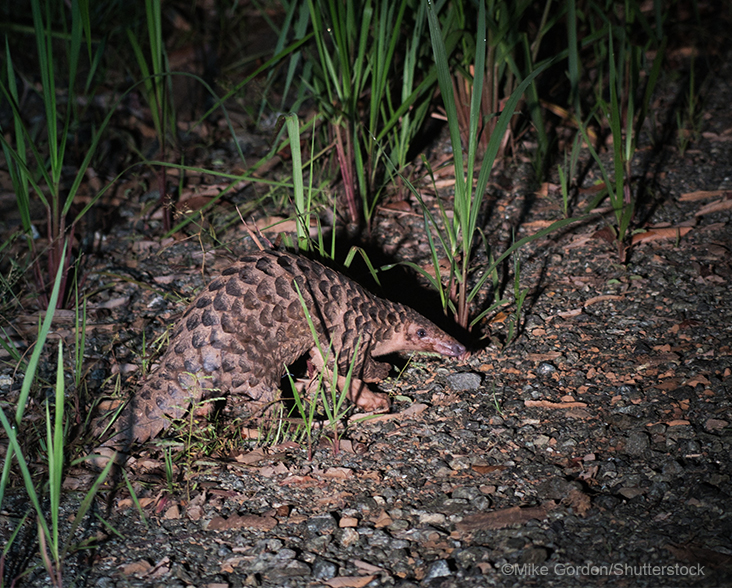Species Data
Class: Mammalia
Order: Pholidota
Family: Manidae
Scientific Name: Manis javanica
IUCN Red List status: Critically Endangered
Description
The Sunda Pangolin is one of eight species of pangolins, or scaly anteaters, those distinctive tropical mammals covered in protective overlapping scales made of keratin. In common with all pangolins, the Sunda Pangolin has a long tail, long snout, and belly and inner side of the legs are unscaled. Like the other three Asian species, the Sunda Pangolin also has bristles between the scales.
Sunda Pangolins reach 122 cm in length, with a head and body length of 40 – 65 cm and a tail measuring 35 – 57 cm. The larger males weigh up to 10 kgs.
This species is distinguished from other Asian pangolins by a combination of morphological features. They have 15-19 cross rows of dark brown scales on the back, fewer than Philippine Pangolin (Manis culionensis) (19 – 21) and more than Indian Pangolin (11 – 13), but a similar number to Chinese Pangolin (M. pentadactyla) (15-18).
However, the Sunda Pangolin has a longer head length (neck to snout) than Chinese and Philippine Pangolins, and the tail is longer and more slender than that of the Chinese Pangolin, frequently with ‘white’ scales, and is fully prehensile, unlike Chinese Pangolin. Unlike Philippine and Indian Pangolins, the head scales of Sunda Pangolin gradually increase in size behind the ears, and the scales behind the ears are slightly keeled. The lifespan of Sunda Pangolin is unknown.
Behaviour
The Sunda Pangolin is insectivorous, feeding primarily on ants and termites, including their larvae, using their excellent sense of smell and hearing to detect ant and termite nests that they rip apart with their long powerful front claws. Using their long sticky tongue that can reach 25 cm, they eat around 200,000 ants or termites per day. Pangolins have no teeth and instead have specially adapted strong stomach walls with protrusions to grind up their food, aided by small stones that they consume.
Mainly nocturnal and partly arboreal, Sunda Pangolins climb trees in search of ant nests and to rest during the day in holes or the foliage of epiphytic plants such as the Bird’s Nest Fern (Asplenium nidus). They will also sleep in burrows dug in soil or amongst fallen logs and within boulder cavities.
Females reach sexual maturity at one year old and give birth to a single offspring in a natal den situated in a hollow in a large tree. Gestation lasts for around six months, and mothers care for their young for three to four months, carrying them on the base of their tails.
The name pangolin derives from the Malay word ‘penggulung’, which translates as ‘roller’, referring to their defensive behaviour of rolling into a scaly ball to protect their soft belly. Although effective against predators such as Tiger (Panthera tigris) or Clouded Leopard (Neofelis nebulosa), this strategy makes them very vulnerable to poaching.


Habitat
The most widely distributed of the four Asian species, the Sunda Pangolin is found from Myanmar in the north, through Thailand, Lao People’s Democratic Republic, Vietnam, Cambodia, Peninsular Malaysia and Singapore, as well as on the Indonesian islands of Sumatra and Java and in Borneo.
This species inhabits primary and secondary forests as well as oil palm and rubber plantations, up to 1,700 metres above sea level. They are competent swimmers and also found in wetlands.
They prefer a tight canopy cover of trees, and the highest densities are reportedly found in primary forest, where there are older trees with hollows suitable for use as dens and for resting.
Threats and Conservation
This species is difficult to observe in the wild, and quantitative data on Sunda Pangolin populations are sparse. However, based on accounts from local communities and trade data, it is estimated that the population declined by 80% from 1998-2019. Therefore, the Sunda Pangolin is listed as Critically Endangered on the IUCN Red List.
The biggest threat to the Sunda Pangolin throughout their range is hunting and poaching. Snares or trained detection dogs are used to catch pangolins, primarily for international trade of live animals, skins, and scales to China and Vietnam, where their scales are used for traditional medicines and the meat prized as a delicacy in restaurants. Secondary threats include habitat loss and local exploitation for meat and other uses.
Data from the Convention on International Trade in Endangered Species (CITES) shows 500,000 Sunda Pangolins recorded as traded between 1975-2018. However, it is estimated another 500,000-935,000 were traded but went unrecorded. Across much of their range, the Sunda Pangolin has become increasingly rare or been lost altogether.
The Sunda Pangolin is protected by legislation in most countries in its range, and this species was added to CITES Appendix I in 2016. In China following the COVID-19 pandemic, this species was upgraded from State Class II protected species to Class I, which prohibits hunting, killing, smuggling, or trading with penalties of up to 10 years in jail. While addressing illegal trade is essential to ensure the survival of this species, it is also vital that habitat and population strongholds are adequately protected.
In July 2021, a flurry of donations from our supporters allowed WLT to close our £150,000 ‘Saving Borneo’s Orangutan Corridors’ appeal on £430,000+, an amount that funded the protection by WLT partner HUTAN of up to five plots of Sunda Pangolin habitat in Malaysian Borneo (the original goal had been to protect two plots.)
